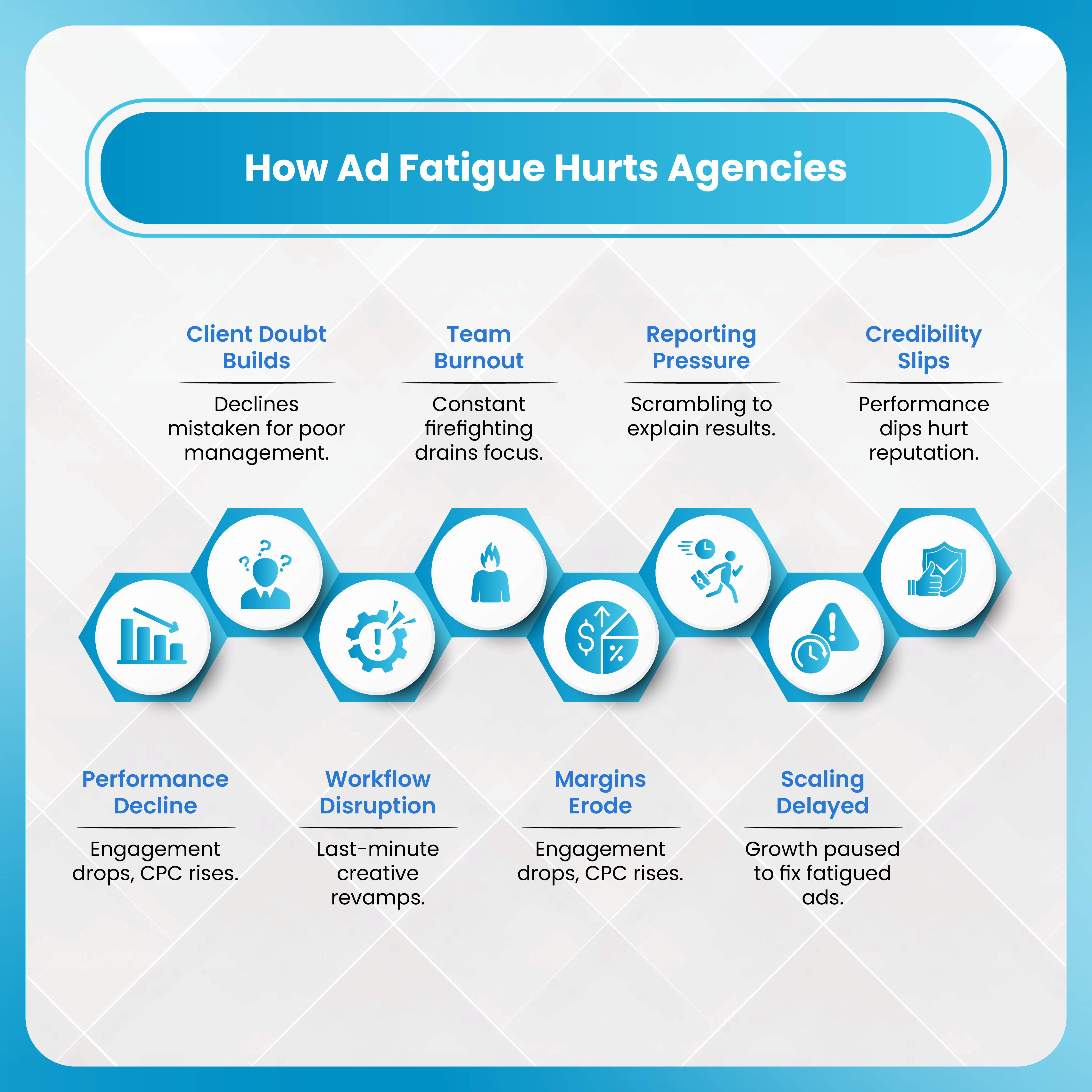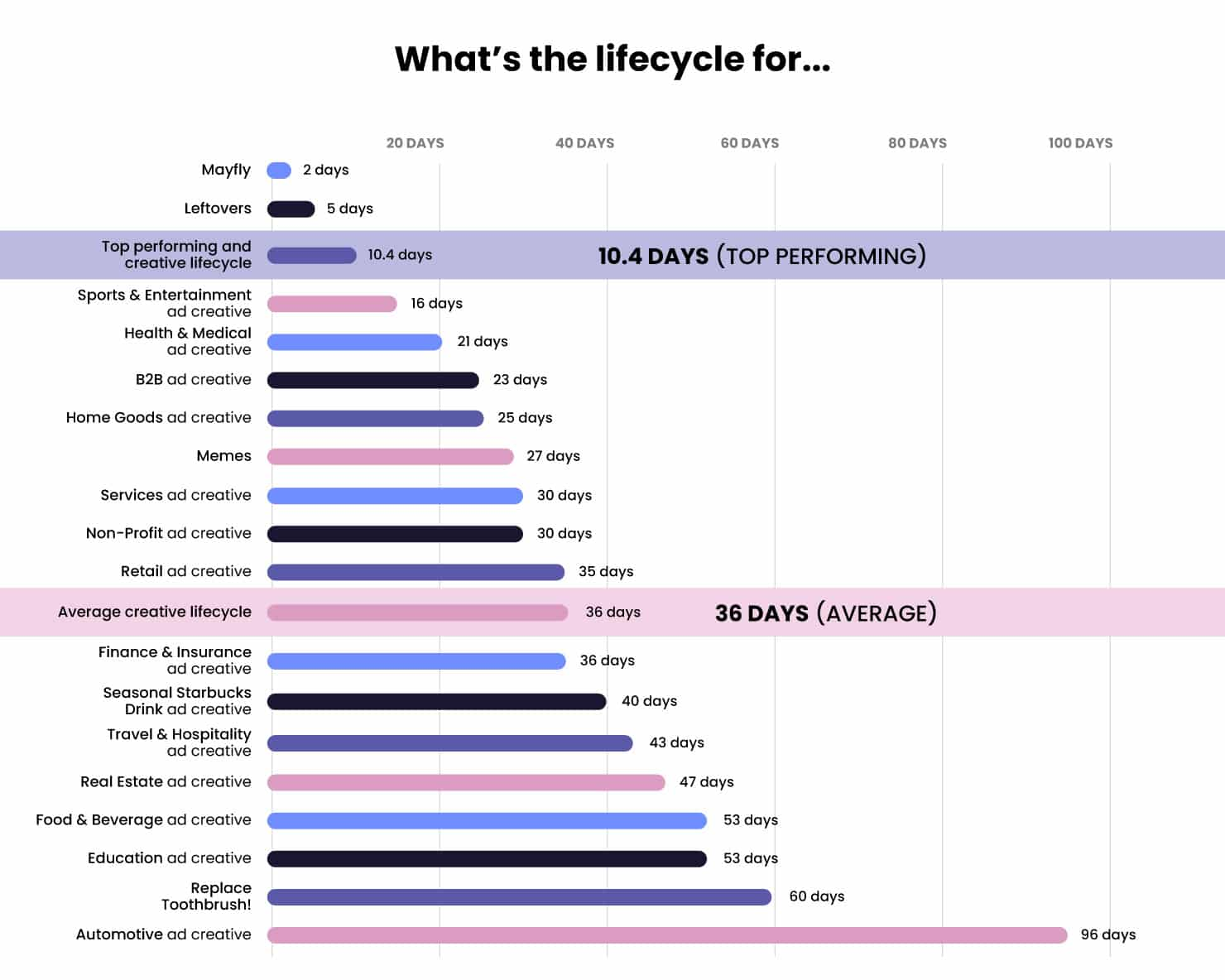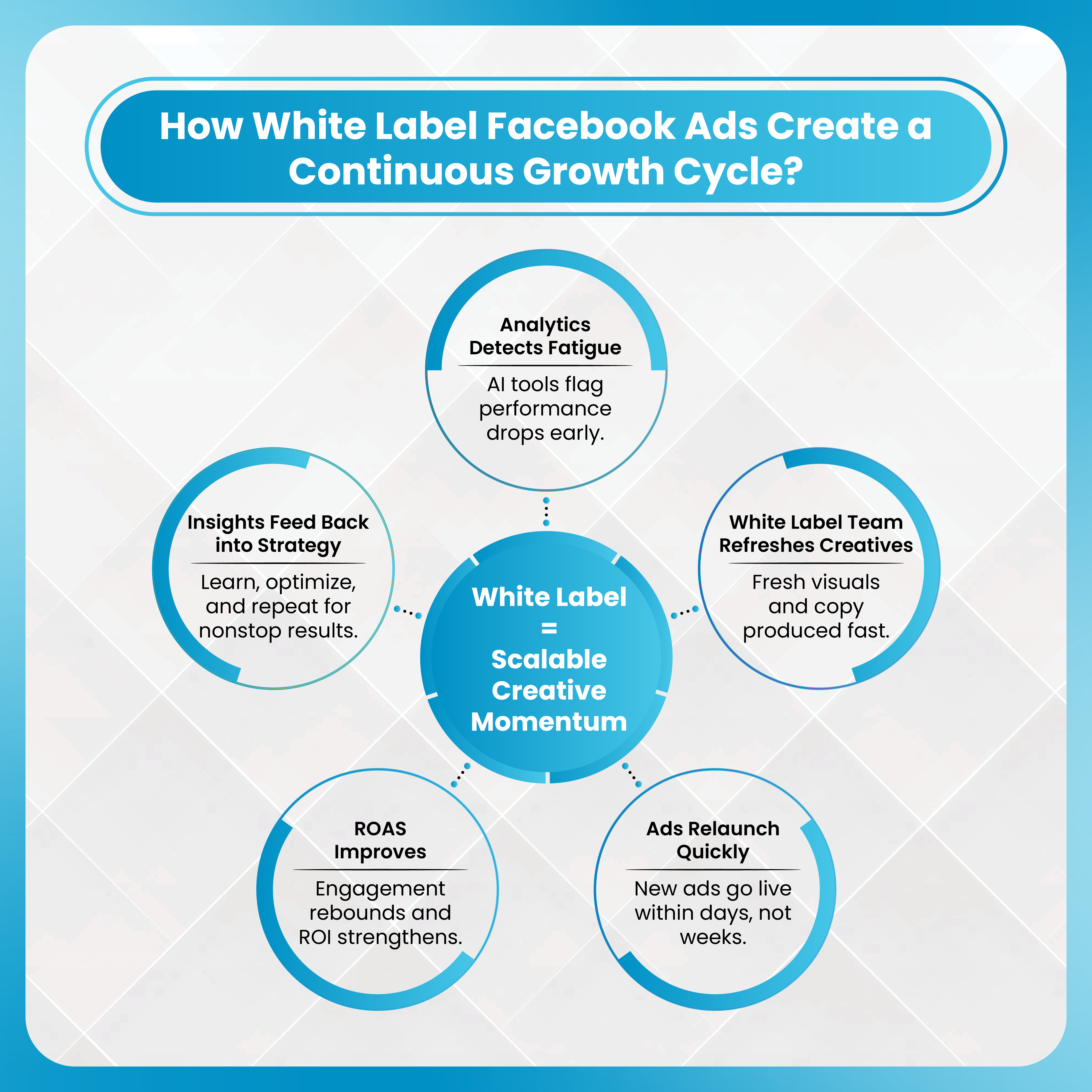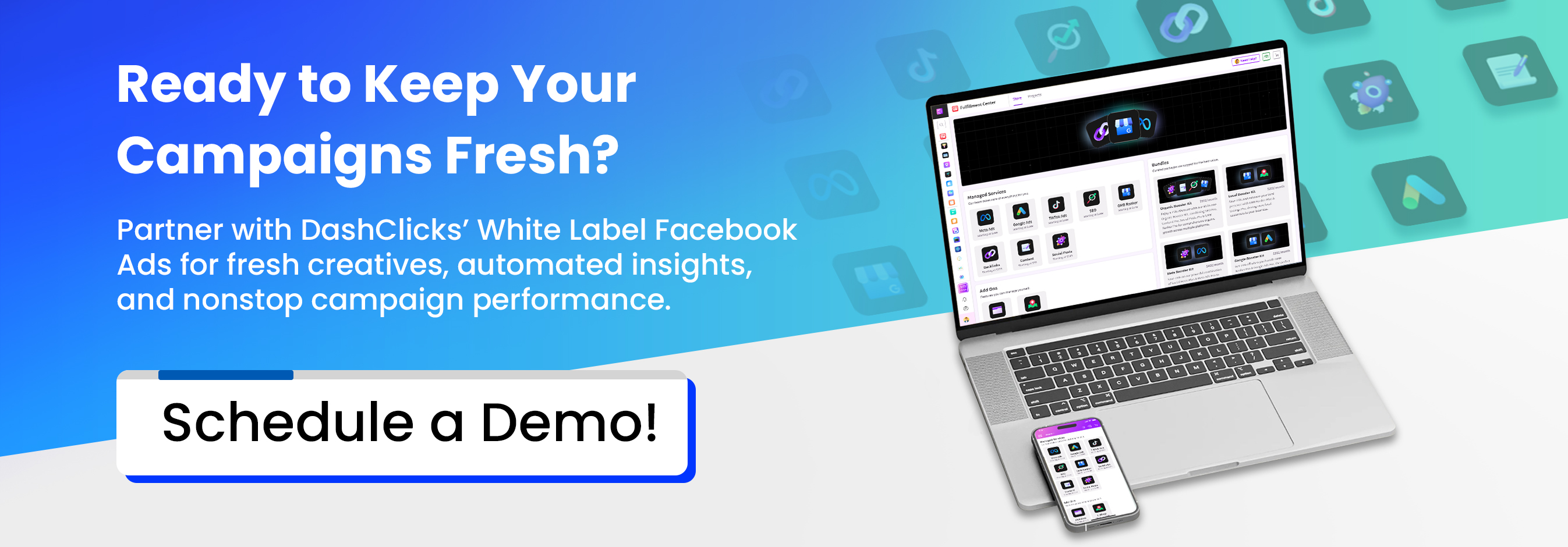Ad fatigue is one of the most persistent and overlooked challenges in digital advertising today. It creeps in quietly — first, your campaign performs well, drawing clicks, conversions, and strong engagement. But after a while, you notice numbers slipping: the click-through rate (CTR) falls, cost-per-click (CPC) starts rising, and conversions taper off. The same ad that once captured attention now blends into the feed like background noise.
This happens because audiences become desensitized to repetitive messaging. People scrolling through Facebook or Instagram have short attention spans, and once they’ve seen an ad multiple times, it loses its novelty. When that happens, the platform’s algorithm interprets declining engagement as a sign that the content isn’t relevant anymore — and starts showing it less frequently or charging more for impressions.
According to Meta’s 2024 Ad Performance Report, campaigns typically experience a 41% drop in CTR after an ad has been shown to the same user more than four times. The same report revealed that advertisers who refreshed creatives every 10–14 days maintained up to 30% higher engagement than those who ran the same visuals for a month or longer. That’s a huge difference in ROI, especially for agencies managing multiple client budgets.
Other studies back this up. Hootsuite’s 2025 Social Trends Report found that the average Facebook ad’s effective lifespan has shortened by nearly 20% since 2022, largely due to increased competition and user content saturation. With more advertisers chasing the same audience pools, creative burnout happens faster than ever.
For digital marketing agencies, this problem multiplies. Managing several campaigns across industries means juggling different fatigue timelines. One client’s ad may perform well for weeks, while another’s crashes after a few days of repetition. Without a structured system to detect fatigue early and refresh efficiently, agencies face a domino effect of underperforming campaigns — each one eroding client confidence and eating into margins.
To stay competitive, agencies need not only strong creative skills but also a repeatable, data-driven process for monitoring fatigue and executing timely refreshes. That’s where Facebook ads services and automated analytics tools can make all the difference.
Why Ad Fatigue Hurts Agencies More Than Brands?
While brands experience the pain of ad fatigue in the form of declining ROI, agencies feel it more acutely — because their performance reflects directly on client satisfaction and retention. When ads stop converting, clients don’t see “fatigue” as the culprit; they see poor management. And for agencies operating in competitive markets, a few underperforming campaigns can quickly turn into lost contracts.
The challenge intensifies for digital marketing agencies handling ten or more accounts simultaneously. Imagine multiple clients across different industries, all running Facebook ads that start fatiguing at once. Suddenly, CTRs drop across the board, costs rise, and every client expects answers — immediately. This not only pressures your ad managers but also disrupts your operations.
Ad fatigue also impacts scalability. When agencies take a reactive approach, refreshing creatives only after performance tanks, they lose control over workload planning. Designers rush to produce replacements, strategists scramble to find new angles, and reporting cycles turn chaotic. What should be a predictable, measured process becomes a scramble that drains resources and morale.
On the financial side, fatigue eats into Return on Ad Spend (ROAS). A campaign that’s running at a healthy 5:1 ROAS can easily dip below 3:1 once engagement drops — and recovering those numbers without a fresh creative push is rare. According to Socialinsider’s 2024 Facebook Ad Benchmark Report, advertisers who delayed refreshing fatigued creatives saw an average 22% increase in CPC and a 17% decrease in conversion rate within two weeks. For agencies managing multiple client budgets, those losses add up fast.
The ripple effects don’t stop at performance metrics. Ad fatigue strains client relationships, too. When results fall, even temporarily, clients may question whether the agency understands their audience or is giving their account enough attention. Maintaining transparency, proactive reporting, and a clear creative refresh process becomes essential to preserving trust.

In short, agencies that treat fatigue as an afterthought end up in a cycle of reaction and recovery. Those that build fatigue management into their workflow — with predictive monitoring, planned refresh intervals, and access to scalable white label Facebook ads support — position themselves not just to survive performance dips, but to consistently outperform competitors.
Understanding the Lifecycle of a Facebook Ad Creative
Every Facebook ad goes through a natural life cycle. It launches, gains traction, performs well for a short time, and then gradually loses its impact. Understanding this cycle helps agencies anticipate when to step in before fatigue starts to erode results.
The length of that cycle depends on several factors — including industry type, creative format, and audience size. According to WordStream’s 2024 Facebook Ad Data Report, most creatives begin to lose efficiency within these general time frames:
- 7–10 days for eCommerce brands, where purchase decisions happen quickly and audiences see the same product repeatedly.
- 14–21 days for B2B or service-based campaigns, which tend to target broader, less impulsive audiences.
- 5–7 days for high-frequency retargeting ads, since they reach the same users more often.

Image Source: Rocketium
That means even the most visually stunning ad isn’t built to last forever. Once the target audience grows accustomed to it, performance declines — usually reflected first in click-through rates and engagement metrics.
Several factors can accelerate fatigue:
- High Ad Frequency: When the same users see your ad too often (usually above 4–6 times), the novelty wears off.
- Audience Overlap: Reusing the same creative across overlapping audiences leads to oversaturation.
- Limited Variety: Relying on one or two visuals prevents new testing opportunities.
- Rapid Scaling: Increasing ad spend too fast can burn through your audience pool before you have time to refresh.
Facebook’s algorithm plays a big role here. Once it detects declining engagement, it prioritizes other ads that are generating stronger user interaction. As a result, your CPM (cost per thousand impressions) climbs while reach shrinks. Essentially, you start paying more to show your ad to fewer people — a clear sign it’s time for a refresh.
In today’s attention economy, this lifecycle is shortening even more. A 2025 Social Media Examiner study found that ad fatigue on Facebook and Instagram now sets in 25% faster than it did just two years ago, largely due to the rise of short-form video and constant content rotation. The faster audiences consume content, the more often advertisers must evolve their creatives to keep up.
Recognizing these patterns helps agencies plan ahead. By tracking creative lifespan by client and industry, teams can build refresh schedules that prevent fatigue rather than react to it.
Detecting Ad Fatigue Early: Metrics That Matter
The key to staying ahead of ad fatigue is spotting it early — before it starts dragging down your campaign ROI. The signs are always visible in your performance data if you know what to look for.
Here are the most reliable indicators:
- CTR (Click-Through Rate): A sudden drop is the first red flag. If your CTR falls consistently over several days, your creative is losing attention.
- CPC (Cost Per Click): Rising CPC often indicates Facebook’s algorithm is compensating for low engagement by charging more for visibility.
- Frequency: Once this crosses 4–6, your audience is likely seeing the ad too often. At this stage, review performance closely.
- Conversion Rate: If your CTR remains steady but conversions dip, it might be a sign that your offer or message no longer resonates.
- Negative Feedback: An increase in ad hides, negative reactions, or spam reports shows users are disengaged or annoyed.
For example, a digital agency recently noticed a gradual decline in CTR from 1.8% to 0.9% over 12 days, while frequency crept up to 5.2. Instead of overhauling the entire campaign, they simply replaced the headline and swapped out the main image. The result? CTR rebounded to 1.6% within three days — proving that minor, data-led tweaks can have major payoffs.
To make detection easier, agencies should rely on analytics tools that automate fatigue monitoring. Meta Ads Manager offers performance breakdowns by frequency, placement, and engagement, helping identify early warning signs. However, tools like DashClicks’ Analytics Software take it further. They allow agencies to track fatigue signals across multiple client accounts in real time and set up automated alerts when performance metrics fall below custom thresholds.
This kind of early detection system gives agencies the breathing room to plan creative refreshes strategically rather than reactively — ensuring performance stability across every client campaign.
When to Refresh Creatives (and When Not To)?
Refreshing too often wastes time; waiting too long wastes money. The key is interpreting data, not guessing.
Scenarios to guide timing:
- High CTR, Low Conversions: Keep the visuals; test new messaging or offers.
- High Frequency, Stable Results: No need to refresh yet; monitor closely.
- Decline Across All Metrics: Replace or adjust creative angles immediately.
A quick decision framework:
- Review the last 7–14 days of performance.
- Compare CTR, CPC, and conversion changes.
- If 2+ metrics drop by 20% or more, refresh.
- Track post-refresh impact within 48–72 hours.
How to Refresh Creatives Effectively Without Burning Budget?
Refreshing creatives doesn’t mean starting over. Agencies can sustain results with smart, small adjustments:
- Rotate Angles — focus on new pain points or customer outcomes.
- Test Alternate Visuals — swap backgrounds, colors, or ad layouts.
- Adjust the Hook — change the opening line or benefit statement.
- Experiment with CTAs — try different phrasing (“Book a Demo” vs. “Get Started Today”).
- Use A/B Tests — isolate one change per version to identify what drives improvement.
Example: In 2024, a marketing agency reported a 27% lift in CTR after refreshing just their primary text and image, keeping the offer and targeting intact—small tweaks, big impact.
Using White Label Facebook Ads to Scale Creative Refresh Cycles
Refreshing creatives regularly sounds simple in theory, but for most agencies, it’s one of the hardest parts of managing paid social campaigns. Between designing visuals, testing variations, analyzing results, and getting client approvals, creative fatigue management quickly becomes a full-time job. That’s where white label Facebook advertising services prove invaluable — giving agencies the ability to scale their operations without hiring additional staff or sacrificing quality.
A white label Facebook ads partner essentially functions as an extension of your team. They handle everything from ad creation and copywriting to performance tracking and optimization — all under your agency’s brand. This means your clients continue to see your agency as the source of all the work, while behind the scenes, a skilled fulfillment team ensures campaigns run smoothly.
Here’s how this model helps agencies stay agile and proactive when managing creative refresh cycles:
- Faster Turnaround: Instead of waiting weeks for a new batch of creatives, agencies can get fresh ads within days. This speed keeps campaigns dynamic and ensures you can respond quickly to fatigue or sudden performance drops.
- Built-in Testing: White label teams typically conduct A/B or multivariate tests as part of the creative process. They experiment with headlines, visuals, and call-to-action s to identify what resonates best with different audiences — something that saves agencies hours of trial and error.
- Transparent Reporting: The best white label providers give agencies access to real-time performance dashboards, making it easy to see which creatives are working and which need replacement. This visibility is essential for maintaining client trust and ensuring accountability.
- Consistent Brand Voice: Even though an external team produces the creatives, they work from detailed brand guidelines provided by the agency. This ensures that every refresh, whether it’s a subtle tweak or a full redesign, stays true to the client’s tone, look, and messaging.

For example, a mid-sized marketing agency in Florida partnered with a white label provider to manage its Facebook ad creative refresh cycles. Before the partnership, each refresh took roughly 14 days to plan, design, approve, and launch. After outsourcing through a white label system, the turnaround time dropped to 5 days. That speed not only helped maintain engagement levels but also freed the internal team to focus on higher-level campaign strategy and client communication.
Another advantage is scalability. With the best white label Facebook ads structure, agencies can easily onboard new clients or expand ad budgets without worrying about bandwidth. The fulfillment team handles the production workload while the agency focuses on results and client relationships.
In the long run, this setup creates a win-win situation: agencies maintain creative agility, clients enjoy consistent campaign performance, and internal teams avoid burnout. When fatigue management is systemized through a trusted white label Facebook Ads partner, agencies can sustain growth without compromising on quality or speed.
The Automation Edge: Integrating AI and Data Tools
AI now plays a major role in managing ad fatigue. Tools like Meta Advantage+, AdCreative.ai, and Pattern89 analyze engagement patterns to predict when fatigue will occur before it impacts results.
By integrating these tools into a white label setup, agencies can:
- Identify fatigue trends early.
- Automate creative recommendations.
- Optimize ad delivery timing.
- Personalize creatives for micro-audiences.
This predictive approach allows agencies to stay ahead of fatigue, saving ad spend and protecting client ROAS.
DashClicks’ Role in Ad Fatigue Management
DashClicks helps digital marketing agencies combat ad fatigue by combining automation, creative analytics, and a structured refresh process under one white label platform. The system monitors ad performance across client accounts, automatically flags creatives showing signs of fatigue, and enables agencies to deploy new variants quickly — all while maintaining consistent branding and campaign transparency.
Their white label Facebook ads team produces fresh, data-driven creatives that align with audience behavior shifts. Agencies can manage everything through a single dashboard, ensuring campaigns stay engaging, cost-efficient, and optimized for conversion. This process not only reduces wasted ad spend but also helps agencies deliver consistent value to their clients without overloading internal creative teams.
Building a Sustainable Creative Refresh Framework for Your Agency
Managing fatigue isn’t a one-time task; it’s an ongoing discipline. Agencies can prevent future burnout by creating a refresh system that runs like clockwork:
- Create a refresh calendar based on industry cycles or performance signals.
- Use client feedback to guide creative direction.
- Run quarterly creative audits to find weak points.
- Document creative tests — what worked, what didn’t, and why.
- Standardize reporting so insights flow between the internal and white label Facebook ads team.
This structure helps agencies plan refreshes proactively instead of reacting to performance dips.
Final Thoughts: Turning Ad Fatigue Into an Agency Advantage
Ad fatigue isn’t a failure — it’s a signal. Every drop in performance offers data on what your audience is tired of and what might excite them next. Agencies that treat fatigue as a learning opportunity build smarter, more resilient campaigns.
By combining analytics, automation, and white label expertise, agencies can stay ahead of fatigue and turn creative refresh cycles into a competitive edge. Proactive management keeps clients confident, campaigns efficient, and results strong.



.svg)

.svg)
.svg)
.svg)
.svg)
.svg)

.svg)




.svg)
.svg)
.svg)
.svg)
.svg)